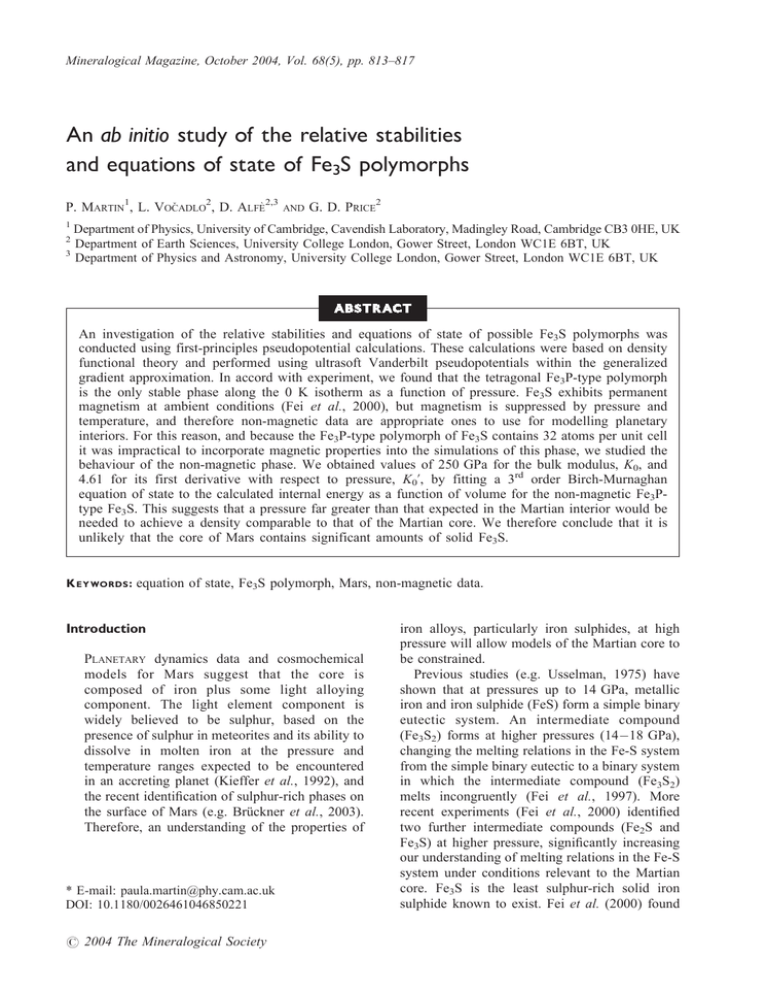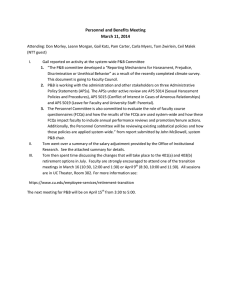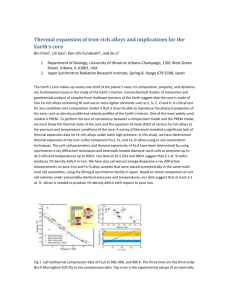An ab initio study of the relative stabilities S polymorphs 3
advertisement

Mineralogical Magazine, October 2004, Vol. 68(5), pp. 813–817 An ab initio study of the relative stabilities and equations of state of Fe3S polymorphs P. MARTIN1, L. VOČADLO2, D. ALFÈ2,3 AND G. D. PRICE2 1 Department of Physics, University of Cambridge, Cavendish Laboratory, Madingley Road, Cambridge CB3 0HE, UK Department of Earth Sciences, University College London, Gower Street, London WC1E 6BT, UK 3 Department of Physics and Astronomy, University College London, Gower Street, London WC1E 6BT, UK 2 ABSTR ACT An investigation of the relative stabilities and equations of state of possible Fe3S polymorphs was conducted using first-principles pseudopotential calculations. These calculations were based on density functional theory and performed using ultrasoft Vanderbilt pseudopotentials within the generalized gradient approximation. In accord with experiment, we found that the tetragonal Fe3P-type polymorph is the only stable phase along the 0 K isotherm as a function of pressure. Fe3S exhibits permanent magnetism at ambient conditions (Fei et al., 2000), but magnetism is suppressed by pressure and temperature, and therefore non-magnetic data are appropriate ones to use for modelling planetary interiors. For this reason, and because the Fe3P-type polymorph of Fe3S contains 32 atoms per unit cell it was impractical to incorporate magnetic properties into the simulations of this phase, we studied the behaviour of the non-magnetic phase. We obtained values of 250 GPa for the bulk modulus, K0, and 4.61 for its first derivative with respect to pressure, K0’, by fitting a 3rd order Birch-Murnaghan equation of state to the calculated internal energy as a function of volume for the non-magnetic Fe3Ptype Fe3S. This suggests that a pressure far greater than that expected in the Martian interior would be needed to achieve a density comparable to that of the Martian core. We therefore conclude that it is unlikely that the core of Mars contains significant amounts of solid Fe3S. K EY WORDS : equation of state, Fe3S polymorph, Mars, non-magnetic data. Introduction PLANETARY dynamics data and cosmochemical models for Mars suggest that the core is composed of iron plus some light alloying component. The light element component is widely believed to be sulphur, based on the presence of sulphur in meteorites and its ability to dissolve in molten iron at the pressure and temperature ranges expected to be encountered in an accreting planet (Kieffer et al., 1992), and the recent identification of sulphur-rich phases on the surface of Mars (e.g. Brückner et al., 2003). Therefore, an understanding of the properties of * E-mail: paula.martin@phy.cam.ac.uk DOI: 10.1180/0026461046850221 # 2004 The Mineralogical Society iron alloys, particularly iron sulphides, at high pressure will allow models of the Martian core to be constrained. Previous studies (e.g. Usselman, 1975) have shown that at pressures up to 14 GPa, metallic iron and iron sulphide (FeS) form a simple binary eutectic system. An intermediate compound (Fe3S2) forms at higher pressures (14 18 GPa), changing the melting relations in the Fe-S system from the simple binary eutectic to a binary system in which the intermediate compound (Fe3S2) melts incongruently (Fei et al., 1997). More recent experiments (Fei et al., 2000) identified two further intermediate compounds (Fe2S and Fe3S) at higher pressure, significantly increasing our understanding of melting relations in the Fe-S system under conditions relevant to the Martian core. Fe3S is the least sulphur-rich solid iron sulphide known to exist. Fei et al. (2000) found P. MARTIN ET AL. that Fe3S forms at pressures between 18 and 21 GPa and that the Fe + Fe3S assemblage is stable up to pressures of at least 23.5 GPa. Using powder X-ray diffraction techniques they found Fe3S to be isostructural with Fe3P (I4̄) and other transition metal phosphides (e.g. Ni3P, Cr3P), having a 32-atom tetragonal unit cell (Fig. 1). They report that there is a eutectic between Fe and Fe3S with eutectic temperature of 1075ºC and eutectic composition of Fe & 15.4 wt.% S, and that the Fe3S compound melts incongruently: Fe3S ? Fe3S2 + liquid. They report that the Fe2S phase is only stable over a narrow temperature range at 21 GPa. The pressure range of the Martian core is estimated to be ~23.5 50 GPa (Folkner et al., 1997). The Fe-S phase diagram at 21GPa reported by Fei et al. (2000) may therefore be taken to be the lowest pressure representation of the Fe-S system under the conditions of the Martian core. Both FeS and Fe3S have large regions of stability at this pressure and their properties are likely to be important in the development of models of the Martian interior. Our investigation of the relative stabilities and equations of state of FeS polymorphs has been previously reported (Martin et al., 2001). In this work Fe3S has been studied in detail using ab initio simulations. Fe3S has been simulated previously (Sherman, 1995), but only as a simple face-centred cubic (AuCu3-type) structure, whereas in this study we have considered several other hypothetical Fe3S polymorphs, ranging from the relatively simple AuCu3-type to the relatively complex Fe3P-type. In order to determine the relative stabilities and equations of state of Fe3S polymorphs as a function of pressure, ab initio calculations have been carried out to determine the internal energy as a function of volume. The calculation methodology is described in the next section. The results of this study are presented in the third section, and in the final section we offer our conclusions. Calculation methodology FIG. 1. Fe3P-type Fe3S structure. 814 The ab initio computer simulations used in this study were based on density functional theory, using ultrasoft Vanderbilt pseudopotentials within the generalized gradient approximation, implemented in the computer program VASP (Kresse and Furthmüller, 1996), and performed on the Cray T3E at the Manchester CSAR facility. All of the pseudopotentials used have been constructed using non-linear partial core corrections (Louie et al., 1982). In the Fe pseudopotential, all electron states up to 3p are treated as core states, i.e. with an [Ne]3s 2 frozen core, while for the S pseudopotential all electron states up to 2p are treated as core states, i.e. with an [Ne] frozen core. The accuracies of these Fe and S pseudopotentials have previously been reported (e.g. Vočadlo et al., 1997; Alfè and Gillan, 1998). Seven polymorphs were considered in the preliminary investigation of Fe3S: the Fe3P-type that has been observed experimentally (Fei et al., 2000), the AuCu3-type that had previously been studied using computer simulations (Sherman, 1995), and five other common structures of R3X compounds (BiF3, LaF3, ReO3, UO3, and YF3) (Wyckoff, 1951). For the AuCu3-type structure, in which all atoms sit on crystallographic special points, the energy of the system was simply found for a range of volumes with fixed atomic positions and unit-cell geometry. For the other structures, the energy of the system was found for a range of volumes, whilst allowing the atoms and cell geometry to relax into their lowest energy configuration for each given volume. The calculations were performed with the number of symmetry unrelated k-points used ranging from 9 to 56, derived using Monkhorst-Pack sampling grids (Monhorst and Pack, 1976) ranging from 36365 to 11611611, with a cutoff energy of ~300 eV. All the total energies were converged to within 0.01 eV per formula unit. Although Fei et al. (2000) reported that the Fe3S phase exhibits permanent magnetism, the large system size of the Fe3P-type polymorph made the computational cost of incorporating magnetic properties into the simulations of this phase prohibitively large, and so spin-polarized calculations were not performed in this study. STABILITIES AND EQUATIONS OF STATE OF FE3S POLYMORPHS -6.2 Results and discussion fcc LaF3-type YF3-type Fe3P-type -6.4 Energy per atom (eV) This study found that the tetragonal Fe3P-type polymorph is the only stable phase along the 0 K isotherm as a function of pressure (Fig. 2). Although mechanically stable, all the other hypothetical Fe3S polymorphs studied were energetically less favourable for all volumes considered. -6.6 -6.8 -7.0 Role of magnetism -7.2 7 Fei et al. (2000) reported that the Fe3S phase exhibits magnetism. In previous studies it has been found that the difference in volume between a magnetically ordered phase (spin unrestricted simulation) and non-magnetically ordered phase (spin restricted simulation) at ambient conditions is of the order of 10%. So, for example, Vočadlo et al. (2002) show that the difference in volume between spin unrestricted and spin restricted simulations of Fe3C is ~7% (Table 1). Hence, we expect that the absence of magnetic components in the simulations would cause the cell parameters, and V0 obtained from them, to be significantly smaller than those observed experimentally. The cell parameters and, as described below, V0 obtained from the simulations of Fe3S were indeed smaller than those found experimentally. However, it is known that ferro- and antiferro-magnetism is suppressed at both the 8 9 10 11 12 13 Volume per atom (A3) FIG. 2. Energy-volume curves for Fe3S polymorphs produced by fitting a 3rd order Birch-Murnaghan equation of state to energy-volume data. high pressures and temperatures found in planetary interiors. Thus, Fe3C loses its magnetic properties at temperatures greater than 483 K (Häglund et al., 1991) and pressures greater than ~60 GPa (Vočadlo et al., 2002). Therefore, we expect that the magnetism in Fe3S would be lost at the high pressures and temperatures found in the Martian core, and consequently it is more appropriate to apply the results of our nonmagnetic simulations of Fe3S to models of such extreme environments, rather than to extrapolate the lower-pressure, magnetic experimental data. TABLE 1. 3rd order Birch-Murnaghan equation of state and structural data for Fe3P-type Fe3S, and, for comparison, 3rd order Birch-Murnaghan equation of state data for non-magnetic and magnetic Fe3C. This study Fe3S (simulation) Non-magnetic V0 (Å3) K0 (GPa) K0’ A (Å) C (Å) 338Q3 250Q3 4.61Q0.04 8.824 4.315 Fractional atomic co-ordinates Tetragonal (I4̄) Fe 0.17369 0.22029 0.75214 0.36152 0.03193 0.96852 0.08271 0.10164 0.23546 S 0.28826 0.04240 0.48603 Fei et al. (2000) Fe3S (experiment) Magnetic 377 377 170Q8 150Q2 2.6Q5 4 9.144Q0.002 4.509Q0.002 Tetragonal (I4̄) 0.17170 0.21950 0.36050 0.03100 0.07930 0.10590 0.29210 0.04540 815 0.75480 0.98600 0.23380 0.49030 Vočadlo et al. (2002) Fe3C (simulation) Non-magnetic Magnetic 8.968Q0.007 316.62Q0.02 4.30Q0.02 9.578Q0.037 173.02Q0.08 5.79Q0.41 P. MARTIN ET AL. needed to achieve such density is predicted to be >100 GPa, far greater than that expected in the Martian interior (~50 GPa), even without considering the effect of thermal pressure. We therefore conclude that it is unlikely that the core of Mars contains significant amounts of solid Fe3S. Structural properties In agreement with experiment, our simulations find a tetragonal unit cell that is isostructural with Fe3P (Fei et al., 2000). Our unit-cell parameters are ~4% smaller than those found experimentally, as expected due to the lack of magnetic components in the simulation. Although the cell parameters obtained from the simulations are significantly smaller than those observed experimentally, the c/a ratio is maintained at ~0.49 (Table 1). The positions of the atoms within the unit cell are within Q0.5% (of the associated cell parameter) of those reported for Fe3P (Wyckoff, 1951). Conclusions Fe3S is the most Fe-rich iron sulphide currently known, and so has been suggested to be a possible component in planetary interiors and specifically the Martian core. This work includes the first simulations of the experimentally observed polymorph of Fe3S, and is the first to consider a variety of other hypothetical polymorphs. We found that the tetragonal Fe3P-type polymorph is the only stable phase along the 0 K isotherm as a function of pressure. Our non-magnetic simulations of Fe3S are the most appropriate to apply the results to models of extreme environments such as the Martian core, as the magnetic moment is lost at high pressures and temperatures. For Fe3S, we predict that pressures over 100 GPa would be required to achieve a density comparable to that expected in the Martian core, and so we conclude that it is unlikely that the core of Mars contains significant amounts of solid Fe3S. Equations of state Values for V0, K0 and K0’ were obtained for the non-magnetic Fe3P-type Fe3S by fitting a 3rd order Birch-Murnaghan equation of state to the data produced via the simulations. Naturally, the K0 obtained from the calculations performed in this study is not directly comparable with that obtained by experiments on the magnetic phase. However, it is recognized that GGA calculations usually give a good description of the bulk modulus as a function of density (e.g. Price et al., 2004). Thus, a plot of bulk modulus as a function of density (Fig. 3) shows that our calculated value of the bulk modulus is in good agreement with the measured value of K at r = 4.2355 g cm 3 (Fei et al., 2000). Within the quasi-harmonic approximation, this figure can also be used to infer the bulk modulus, and hence the seismic parameter, at conditions relevant to the Martian core, where r & 6 g cm 3 (Kieffer et al., 1992). However, we note that the pressure FIG. 3. Bulk modulus as a function of density for Fe3Ptype Fe3S from simulation (this study) and experiment (Fei et al., 2000). Acknowledgements This work was supported by the Natural Environment Research Council grant number GT0498ES185. References Alfé, D. and Gillan, M.J. (1998) First-principles simulations of liquid Fe-S under Earth’s core conditions. Physical Review B, 58, 8248 8256. Brückner, J., Dreibus, G., Rieder, R. and Wanke, H. (2003) Refined data of Alpha Proton X-ray Spectrometer analyses of soils and rocks at the Mars Pathfinder site: Implications for surface chemistry. Journal of Geophysical Research, 108, (E12), 8094, doi:10.1029/2003JE002060. Fei, Y., Bertka, C.M. and Finger, L.W. (1997) Highpressure iron sulphur compound Fe3S2 and melting relations in the Fe-FeS system. Science, 275, 1621 1623. Fei, Y., Li, J., Bertka, C.M. and Prewitt, C.T. (2000) Structure type and bulk modulus of Fe3S, a new ironsulphur compound. American Mineralogist, 85, 1830 1833. 816 STABILITIES AND EQUATIONS OF STATE OF FE3S POLYMORPHS Folkner, W.M., Yoder, C.F., Yuan, D.N., Standish, E.M. and Preston, R.A. (1997) Interior structure and seasonal mass redistribution of Mars from radio tracking of Mars Pathfinder. Science, 278, 1749 1752. Häglund, J., Grimvall, G. and Jarlborg, T. (1991) Electronic structure, X-ray photoemission spectra, and transport properties of Fe 3C (cementite), Physical Review B, 44, 2914 2919. Kieffer, H.H., Jakosky, B.M., Snyder, C.W. and Matthews, M.S., editors (1992) Mars. University of Arizona Press, Tucson, Arizona, 1536 pp. Kresse, G. and Furthmüller, J (1996) Efficient iterative schemes for ab initio total energy calculations using plane-wave basis sets. Physical Review B, 54, 11169 11186. Louie, S.G., Froyen, S. and Cohen, M.L. (1982) Nonlinear ionic pseudo potentials in spin-density functional calculations. Physical Review B, 26, 1738 1742. Martin, P., Price, G.D. and Vočadlo, L. (2001) An Ab Initio study of the relative stabilities and equations of state of FeS polymorphs. Mineralogical Magazine, 65, 181 191. Monkhorst, H.J. and Pack, J.D. (1976) Special points for Brillouin-zone integrations. Physical Review B, 13, 5188 5192. Price, G.D., Alfé, D., Vočadlo, L. and Gillan, M.J. (2004) The Earth’s core: an approach from first principles. In: The State of the Planet (S.J. Sparks and C.J. Hawksworth, editors). Geophysical Monograph Series, American Geophysical Union, Washington, D.C. (in press). Sherman, D.M. (1995) Stability of possible Fe-FeS and Fe-FeO alloy phases at high pressure and the composition of the Earth’s core. Earth and Planetary Science Letters, 132, 87 98. Usselman, T.M. (1975) Experimental approach to the state of the core: part 1. The liquidus relations of the Fe-rich portion of the Fe-Ni-S system from 30 to 100 kb. American Journal of Science, 275, 278 290. Vočadlo, L., de Wijs, G.A., Kresse, G., Gillan, M.J. and Price, G.D. (1997) First principles calculations on crystalline and liquid iron at Earth’s core conditions, Faraday Discussions, 106, 205 217. Vočadlo, L., Brodholt, J.P., Dobson, D., Knight, K.S., Marshall, W.G., Price, G.D. and Wood, I.G. (2002) The effect of ferromagnetism on the equation of state of Fe3C studied by first-principles calculations. Earth and Planetary Science Letters, 203, 567 575. Wyckoff, R.W.G. (1951) Crystal Structures, 2nd edition. John Wiley & Sons, New York. [Manuscript received 7 June 2004: revised 4 August 2004] 817




